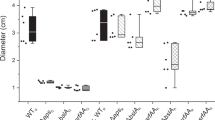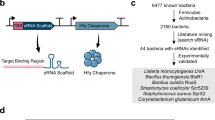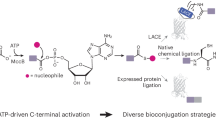Abstract
Bacteria produce a variety of peptides to mediate nutrient acquisition, microbial interactions and other physiological processes. Of special interest are surface-active peptides that aid in growth and development. Herein we report the structure and characterization of clavusporins, unusual and hydrophobic ribosomal peptides with multiple C-methylations at unactivated carbon centers, which help drastically reduce the surface tension of water and thereby aid in Streptomyces development. The peptides are synthesized by a previously uncharacterized protein superfamily, termed DUF5825, in conjunction with a vitamin B12-dependent radical S-adenosylmethionine metalloenzyme. The operon encoding clavusporins is widespread among actinomycete bacteria, suggesting a prevalent role for clavusporins as morphogens in erecting aerial hyphae and thereby advancing sporulation and proliferation.

This is a preview of subscription content, access via your institution
Access options
Access Nature and 54 other Nature Portfolio journals
Get Nature+, our best-value online-access subscription
$32.99 / 30 days
cancel any time
Subscribe to this journal
Receive 12 print issues and online access
$259.00 per year
only $21.58 per issue
Buy this article
- Purchase on SpringerLink
- Instant access to full article PDF
Prices may be subject to local taxes which are calculated during checkout




Similar content being viewed by others
Data availability
Experimental data supporting the conclusions of this study are available within the article and Supplementary Information. Protein sequences were retrieved from the NCBI Nonredundant Protein Database (http://www.ncbi.nlm.nih.gov/protein/) and NCBI accession numbers of proteins in the S. clavuligerus and S. ghanaensis BGCs are as follows: WP_003958126.1(MpcT), WP_003958125.1 (MpcP), WP_003958123.1 (MpcB), WP_003958122.1 (MpcC), WP_004993370.1 (MpgT), WP_004993372.1 (MpgP), WP_004993375.1 (MpgB), WP_004993376.1 (MpgC). Raw NMR data used to elucidate natural product structures as well as the other data in this paper are available from the corresponding author upon request. Source data are provided with this paper.
References
Clardy, J. & Walsh, C. Lessons from natural molecules. Nature 432, 829–837 (2004).
Salvador-Reyes, L. A. & Luesch, H. Biological targets and mechanisms of action of natural products from marine cyanobacteria. Nat. Prod. Rep. 32, 478–503 (2015).
Wang, R. & Seyedsayamdost, M. R. Hijacking exogenous signals to generate new secondary metabolites during symbiotic interactions. Nat. Rev. Chem. 1, 0021 (2017).
Van der Meij, A., Worsley, S. F., Hutchings, M. I. & van Wezel, G. P. Chemical ecology of antibiotic production by actinomycetes. FEMS Microbiol. Rev. 41, 392–416 (2017).
Bassler, B. L. & Losick, R. Bacterially speaking. Cell 125, 237–246 (2006).
Hider, R. C. & Kong, X. Chemistry and biology of siderophores. Nat. Prod. Rep. 27, 637–657 (2010).
Khan, S. H., Ahmad, N., Ahmad, F. & Kumar, R. Naturally occurring organic osmolytes: from cell physiology to disease prevention. IUBMB Life 62, 891–895 (2010).
Ron, E. Z. & Rosenberg, E. Natural roles of biosurfactants. Environ. Microbiol. 3, 229–236 (2001).
Straight, P. D., Willey, J. M. & Kolter, R. Interactions between Streptomyces coelicolor and Bacillus subtilis: role of surfactants in raising aerial structures. J. Bacteriol. 188, 4918–4925 (2006).
Bibb, M. J. Regulation of secondary metabolism in streptomycetes. Curr. Opin. Microbiol. 8, 208–215 (2005).
Flärdh, K. & Buttner, M. J. Streptomyces morphogenetics: dissecting differentiation in a filamentous bacterium. Nat. Rev. Microbiol. 7, 36–49 (2009).
Chater, K. F. Recent advances in understanding Streptomyces. F1000Res. 5, 2795 (2016).
McCormick, J. R. & Flärdh, K. Signals and regulators that govern Streptomyces development. FEMS Microbiol. Rev. 36, 206–231 (2012).
Tillotson, R. D., Wösten, H. A., Richter, M. & Willey, J. M. A surface active protein involved in aerial hyphae formation in the filamentous fungus Schizophillum commune restores the capacity of a bald mutant of the filamentous bacterium Streptomyces coelicolor to erect aerial structures. Mol. Microbiol. 30, 595–602 (1998).
Wösten, H. A. B. & Willey, J. M. Surface-active proteins enable microbial aerial hyphae to grow into the air. Microbiology 146, 767–773 (2000).
Gavriilidou, A. et al. Compendium of specialized metabolite biosynthetic diversity encoded in bacterial genomes. Nat. Microbiol. 7, 726–735 (2022).
Kodani, S. et al. The SapB morphogen is a lantibiotic-like peptide derived from the product of the developmental gene ramS in Streptomyces coelicolor. Proc. Natl Acad. Sci. USA 101, 11448–11453 (2004).
Willey, J., Santamaria, R., Guijarro, J., Geistlich, M. & Losick, R. Extracellular complementation of a developmental mutation implicates a small sporulation protein in aerial mycelium formation by S. coelicolor. Cell 65, 641–650 (1991).
Montalbán-López, M. et al. New developments in RiPP discovery, enzymology and engineering. Nat. Prod. Rep. 38, 130–239 (2021).
Álvarez-Álvarez, R. et al. A 1.8-Mb-reduced Streptomyces clavuligerus genome: relevance for secondary metabolism and differentiation. Appl. Microbiol. Biotechnol. 98, 2183–2195 (2014).
Söding, J., Biegert, A. & Lupas, A. N. The HHpred interactive server for protein homology detection and structure prediction. Nucleic Acids Res. 33, W244–W248 (2005).
Broderick, J. B., Duffus, B. R., Duschene, K. S. & Shepard, E. M. Radical S-adenosylmethionine enzymes. Chem. Rev. 114, 4229–4317 (2014).
Frey, P. A., Hegeman, A. D. & Ruzicka, F. J. The radical SAM superfamily. Crit. Rev. Biochem. Mol. Biol. 43, 63–88 (2008).
Landgraf, B. J., McCarthy, E. L. & Booker, S. J. Radical S-adenosylmethionine enzymes in human health and disease. Annu. Rev. Biochem. 85, 485–514 (2016).
Zhang, Q., van der Donk, W. A. & Liu, W. Radical-mediated enzymatic methylation: a tale of two SAMS. Acc. Chem. Res. 45, 555–564 (2012).
Bauerle, M. R., Schwalm, E. L. & Booker, S. J. Mechanistic diversity of radical S-adenosylmethionine (SAM)-dependent methylation. J. Biol. Chem. 290, 3995–4002 (2015).
Zhou, S. et al. Mechanistic insights into class B radical-S-adenosylmethionine methylases: ubiquitous tailoring enzymes in natural product biosynthesis. Curr. Opin. Chem. Biol. 35, 73–79 (2016).
Huo, L. et al. Synthetic biotechnology to study and engineer ribosomal bottromycin biosynthesis. Chem. Biol. 19, 1278–1287 (2012).
Freeman, M. F. et al. Metagenome mining reveals polytheonamides as posttranslationally modified ribosomal peptides. Science 338, 387–390 (2012).
Crone, W. J. K. et al. Dissecting bottromycin biosynthesis using comparative untargeted metabolomics. Angew. Chem. Int. Ed. Engl. 55, 9639–9643 (2016).
Freeman, M. F. et al. Seven enzymes create extraordinary molecular complexity in an uncultivated bacterium. Nat. Chem. 9, 387–395 (2017).
Noike, M. et al. A peptide ligase and the ribosome cooperate to synthesize the peptide pheganomycin. Nat. Chem. Biol. 11, 71–76 (2015).
Parent, A. et al. The B12-radical SAM enzyme PoyC catalyzes valine Cβ-methylation during polytheonamide biosynthesis. J. Am. Chem. Soc. 138, 15515–15518 (2016).
Schmitt-John, T. & Engels, J. W. Promoter constructions for efficient secretion expression in Streptomyces lividans. Appl. Microbiol. Biotechnol. 36, 493–498 (1992).
Guijarro, J., Santamaria, R., Schauer, A. & Losick, R. Promoter determining the timing and spatial localization of transcription of a cloned Streptomyces coelicolor gene encoding a spore-associated polypeptide. J. Bacteriol. 170, 1895–1901 (1988).
Hamada, T. et al. Solution structure of polytheonamide B, a highly cytotoxic nonribosomal polypeptide from marine sponge. J. Am. Chem. Soc. 132, 12941–12945 (2010).
Woolfrey, S. G., Banzon, G. M. & Groves, M. J. The effect of sodium chloride on the dynamic surface tension of sodium dodecyl sulfate solutions. J. Colloid Interface Sci. 112, 583–587 (1986).
Higgens, C. E. & Kastner, R. E. Streptomyces clavuligerus sp. nov., a β-lactam antibiotic producer. Int. J. Syst. Bacteriol. 21, 326–331 (1971).
Sinner, E. K., Marous, D. R. & Townsend, C. A. Evolution of methods for the study of cobalamin-dependent radical SAM enzymes. ACS Bio. Med. Chem. Au 2, 4–10 (2022).
Lanz, N. D. et al. Enhanced solubilization of class b radical S-adenosylmethionine methylases by improved cobalamin uptake in Escherichia coli. Biochemistry 57, 1475–1490 (2018).
Blaszczyk, A. J., Wang, R. X. & Booker, S. J. TsrM as a model for purifying and characterizing cobalamin-dependent radical S-adenosylmethionine methylases. Methods Enzymol. 595, 303–329 (2017).
Tietz, J. I. et al. A new genome-mining tool redefines the lasso peptide biosynthetic landscape. Nat. Chem. Biol. 13, 470–478 (2017).
Gerlt, J. A. Genomic enzymology: web tools for leveraging protein family sequence-function space and genome context to discover novel functions. Biochemistry 56, 4293–4308 (2017).
Blin, K. et al. antiSMASH 7.0: new and improved predictions for detection, regulation, chemical structures and visualisation. Nucleic Acids Res. 51, W46–W50 (2023).
Burkhart, B. J., Hudson, G. A., Dunbar, K. L. & Mitchell, D. A. A prevalent peptide-binding domain guides ribosomal natural product biosynthesis. Nat. Chem. Biol. 11, 564–570 (2015).
Bhushan, A., Egli, P. J., Peters, E. E., Freeman, M. F. & Piel, J. Genome mining- and synthetic biology-enabled production of hypermodified peptides. Nat. Chem. 11, 931–939 (2019).
Paoli, L. et al. Biosynthetic potential of the global ocean microbiome. Nature 607, 111–118 (2022).
Zhang, S. et al. Structural diversity, biosynthesis, and biological functions of lipopeptides from Streptomyces. Nat. Prod. Rep. 40, 557–594 (2023).
Ishikawa, J. & Hotta, K. FramePlot: a new implementation of the Frame analysis for predicting protein-coding regions in bacterial DNA with a high G + C content. FEMS Microbiol. Lett. 174, 251–253 (1999).
Frith, M. C., Saunders, N. F. W., Kobe, B. & Bailey, T. Discovering sequence motifs with arbitrary insertions and deletions. PLoS Comput. Biol. 4, e1000071 (2018).
Acknowledgements
We thank the Seyedsayamdost Lab members for helpful discussions, J. Schreiber (Princeton University) for assistance in SEM experiments, D. Potapenko (Princeton University) for guidance in surface tension measurement and I. Pelczer (Princeton University) for collecting NMR data. We thank the National Institutes of Health (R01 GM140034 and R35 GM152049 to M.R.S.) for financial support.
Author information
Authors and Affiliations
Contributions
C.Z. and M.R.S. conceived of the project. C.Z. designed and performed all experiments and analyzed data if not otherwise stated. Y.L. generated mpc cluster knockout and performed qPCR analysis. E.N.O. and C.Z. conducted chemical complementation experiments. C.Z. and M.R.S. wrote the paper with contributions from all authors.
Corresponding author
Ethics declarations
Competing interests
M.R.S. is cofounder of Cryptyx Bioscience and a consultant to Merck Co. These entities played no role in the current study. The other authors declare no competing interests.
Peer review
Peer review information
Nature Chemical Biology thanks the anonymous reviewer(s) for their contribution to the peer review of this work.
Additional information
Publisher’s note Springer Nature remains neutral with regard to jurisdictional claims in published maps and institutional affiliations.
Extended data
Extended Data Fig. 1 Structural elucidation of clavusporins.
a,b, UPLC-coupled HRMS analysis of extracts of WT S. clavuligerus and the deletion mutants indicated. Shown are extracted ion chromatograms of clavusporin A (a) and clavusporin B (b). The traces are offset on the y axis for clarity. Each experiment was repeated with at least three biological replicates, and representative results are shown. c, Key NMR correlations used for determination of post-translational methylations in clavusporin B. d, Key NMR correlations used for determination of the overall structure of clavusporin B.
Extended Data Fig. 2 Phenotypic differences of WT S. clavuligerus and mpc mutants.
a–c, Images of WT S. clavuligerus (a), ΔmpcB (b) and ΔmpcC (c) growing on GYM agar for 10 days. Note the green spores produced by the WT. d–f, SEM images of WT (d), ΔmpcB (e) and ΔmpcC (f), which confirm sporulation in WT, and minimal aerial hyphae growth in mutants. Each experiment was repeated in three biological replicates, and representative results are shown.
Extended Data Fig. 3 Phenotypic differences between WT S. ghanaensis and the mpgB mutant.
a, The orthologous mpg gene cluster in S. ghanaensis. The gene locus of mpgA is marked by a black circle, and its protein sequence is shown. b,c, Images of WT S. ghanaensis (b) and ΔmpgB S. ghanaensis (c) growing on SFM agar for 3 days. Note the robust production of dark gray spores by the WT. d,e, SEM images of WT (d) and ΔmpgB S. ghanaensis (e), which show typical formation of Streptomyces spore chains in WT. Each experiment was repeated in three biological replicates, and representative results are shown.
Extended Data Fig. 4 MpcP is a site-specific leader peptidase.
a, HPLC–HRMS analysis of the MpcP reaction with NusA-MpcA. Heat-inactivated MpcP and a no-enzyme reaction were used as controls. Shown are extracted ion chromatograms of MpcA1-21. b, HPLC–HRMS analysis of trypsin-digested NusA-MpcA as a positive control of MpcP assay. Shown are extracted ion chromatograms of two tryptic fragments of MpcA, MpcA1–13 (blue) and MpcA(−15)–(−1) (red). c, HPLC–HRMS analysis of MpcP-treated MBP-MpcA fusion, which was coexpressed with MpcBC in E. coli. Shown are extracted ion chromatograms of MpcA1–21 with different methylation states. The traces are offset on the y axis for clarity. Each experiment was repeated in three biological replicates, and representative results are shown.
Supplementary information
Supplementary Information
Supplementary Note, Tables 1–10 and Figs. 1–11.
Source data
Source Data Fig. 1
Unprocessed MS signal file.
Source Data Fig. 2
Raw surface tension data and uncropped images.
Source Data Fig. 3
Raw extracted ion chromatogram data.
Source Data Fig. 4
Precursor peptide sequences and uncropped logo plots.
Source Data Extended Data Fig. 1
Raw extracted ion chromatogram data.
Source Data Extended Data Fig. 2
Uncropped images.
Source Data Extended Data Fig. 3
Uncropped images.
Source Data Extended Data Fig. 4
Raw extracted ion chromatogram data.
Rights and permissions
Springer Nature or its licensor (e.g. a society or other partner) holds exclusive rights to this article under a publishing agreement with the author(s) or other rightsholder(s); author self-archiving of the accepted manuscript version of this article is solely governed by the terms of such publishing agreement and applicable law.
About this article
Cite this article
Zhang, C., Li, Y., Overton, E.N. et al. Peptide surfactants with post-translational C-methylations that promote bacterial development. Nat Chem Biol 21, 1069–1075 (2025). https://doi.org/10.1038/s41589-025-01882-8
Received:
Accepted:
Published:
Issue date:
DOI: https://doi.org/10.1038/s41589-025-01882-8



